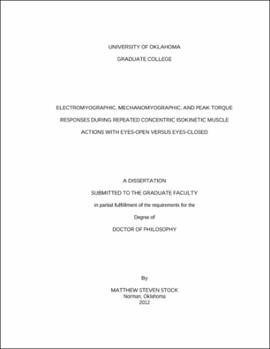| dc.description.abstract | The purpose of this study was to compare the peak torque and electromyographic (EMG) and mechanomyographic (MMG) amplitude and mean frequency (MNF) responses during fatiguing isokinetic muscle actions for eyes-open versus eyes-closed conditions. Twenty-one resistance-trained men (mean ± SD age = 23.0 ± 3.0 years; body mass = 86.9 ± 14.4 kg) volunteered to participate in this investigation. Following a familiarization session, each subject participated in four data collection trials. For each trial, the subjects performed 100 repeated maximal concentric isokinetic muscle actions of the dominant forearm flexors with 1) their eyes open (100Open), 2) their eyes closed (100Closed), 3) their eyes open and closed for the first and last 50 muscle actions (50Open50Closed), respectively, and 4) their eyes closed and open for the first and last 50 muscle actions (50Closed50Open), respectively. During each muscle action, EMG and MMG signals were detected from the biceps brachii. For each fatigue test, the data for the first and last 50 muscle actions served as the pre-test (Pre) and post-test (Post), respectively, and were compared for each condition. Initial peak torque (average from the three repetitions with the highest peak torque values), final peak torque (average from the three repetitions with the lowest peak torque values), percent decline ([initial peak torque - final peak torque/initial peak torque] × 100), average torque (average peak torque value across the 50 repetitions), and the linear slope coefficient for the decline in peak torque (ft.-lbs./repetition) were the five isokinetic peak torque variables in this study. In addition, for each subject and condition, the normalized EMG and MMG amplitude and MNF data points at initial and final peak torque were averaged and utilized for subsequent statistical analyses. The results indicated that there were no mean differences among the conditions for the five isokinetic peak torque variables. The mean normalized EMG MNF values at final peak torque decreased from Pre to Post for 100Open and 50Closed50Open conditions, but not for the eyes-closed conditions (i.e., 100Closed and 50Open50Closed). For the 100Open and 100Closed conditions, there were no Pre versus Post mean differences for normalized MMG MNF at final peak torque. When the subjects opened (50Closed50Open) and closed (50Open50Closed) their eyes after 50 repetitions, however, the normalized MMG MNF values continued to decrease. These findings suggested that visual feedback did not influence maximal strength or fatigability, but did affect EMG and MMG MNF. | |
